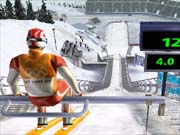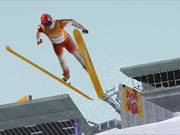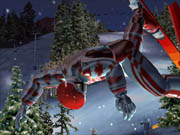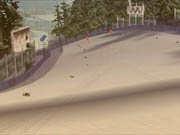In February 2002, hundreds of athletes from 84 nations gathered in and around Salt Lake City, Utah, to participate in the Olympic Winter Games. Thirteen separate sporting categories were on display at this iteration of the Games, subdivided into scores of individual events unfolding at dozens of different venues. Speed skating alone offered a total of 18 distinct disciplines and alpine skiing another 10. That's a lot of sports, a lot of pageantry, and a lot of ground to cover for any PC game wishing to bring you a playable version of this remarkable occasion. Nevertheless, into the post-Games hangover wades Infogrames with the impressively titled but disappointingly endowed Salt Lake 2002. Despite a slick presentation and several clearly enjoyable moments, Salt Lake fails to capture the magnitude of this periodic winter spectacle and is in reality an entertaining yet brief whirl through just a fraction of the events you might expect.

Six events do not make an Olympics, yet that is precisely the number that Infogrames and developer Attention to Detail has infused into Salt Lake, the "official" computer game of the 2002 Winter Olympics. Worse still, the events that are included are nowhere near a logical cross-section of the Winter Olympics schedule. You say you enjoy hockey, speed skating, and figure skating? Forget it--they didn't make the cut. Nor did cross-country skiing, curling, women's hockey, or more esoteric stuff such as biathlon and Nordic skiing. Instead, the computerized Winter Olympics has been boiled down to a half-dozen rather similar disciplines--men's alpine skiing downhill, men's ski jumping K120 Individual, men's snowboard parallel giant slalom, women's alpine skiing slalom, women's freestyle skiing aerials, and men's two-man bobsleigh. And that simply isn't enough for a game that outwardly appears to represent the entire experience.
Furthermore, none of the six sports that did manage to find their way into the program are blessed with a particularly complex control scheme. The one exception to the rule is freestyle skiing aerials, in which you are asked to preselect from a wide variety of single, double, or triple maneuvers and then perform a number of timed button clicks as the athlete descends the slope and launches herself into the air. Although you won't actually control the direction or speed of your onscreen persona inasmuch as you coordinate her airborne movements, it is a tricky proposition nonetheless that often forces you to disregard the pretty pictures and concentrate on frenzied button clicking.
Conversely, ski jumping is curiously simplistic. Here, you'll find yourself perched at the top of the jump ramp, monitoring an animated windsock to best determine when the prevailing breezes are strongest and offer the most lift. When the sock fills with air, you'll click a button to initiate your athlete's run and then sit back and watch as he autopilots himself toward the base of the ramp, where you'll attempt to depress another button at precisely the same moment he passes a superimposed "takeoff" marker. You'll then use the D-pad on your controller to keep his skis at optimum position as he floats through the skies and perform one more timed click as he prepares to touch down.

All three downhill skiing disciplines--men's alpine skiing, women's alpine skiing slalom, and men's snowboard parallel giant slalom--work on a different premise than the ski jump. In each event, you'll be asked to press the D-pad on its left or right edges to negotiate the numerous gates strewn about the various courses. Men's alpine skiing is clearly the fastest of the three and demands that you set up early for the next gate (or gates) even as you're hurtling through those above it. It also compels you to sporadically tuck and untuck to accelerate for the straightforward sections and decelerate for the complicated bits. Both women's alpine skiing slalom and men's snowboard parallel giant slalom feature tighter gate arrangements, gentler inclines, and slower speeds, thereby forcing you to be even more aggressive with not only side-to-side maneuvering but also initiating additional actions, such as "jump turns" and "poling." However, as none of the downhill sports ever let you take full command of all your skier's movements and body positioning, you'll more often feel like an onboard coach as opposed to a true participant.
Much like in real life, men's two-man bobsleigh may be the oddest event of the bunch. Although the sensation of speed is really quite convincing, the simple fact is that there really isn't much to do on a walled, constrictive, and completely predetermined course. You will be asked to manipulate two buttons at the beginning of each run as your athletes push their sleigh and then clamber in, but from then on you'll merely steer a few inches this way or that to remain in the middle of the track and prevent your snow rocket from losing momentum or tipping over.
However, if you can look past the abbreviated schedule and the seeming simplicity of the control configurations, Salt Lake 2002 is not completely without merit. For starters, each sport is deceptively difficult to master, particularly when you increase the opponent capability. Those microscopic steering adjustments in men's bobsleigh, for example, become far more critical when you know that just one slip-up, just one extra brush against the wall, could be the difference between a gold medal or an off-the-podium finish. The same sort of logic applies in all three downhill events, wherein precious milliseconds separate first place from 10th place and even the slightest error in judgment could cost you a shot at the championship. Ski jumping seems curiously easy at all levels, yet women's aerials are pretty dang challenging throughout.

The game offers several playing options, the primary of which is Olympic mode. Here, you'll participate in any or all of the events without the advantage of a practice run and with medals hanging in the balance. By selecting all six disciplines in this mode, you'll not only experience a series of impressive postevent medal presentations and celebrations, but also some of the pomp and pageantry of a real Olympic opening and closing ceremony. Classic mode and knockout mode deliver several varieties of one-off arcade-type competition, and freeform mode lets you sharpen your moves, unhindered by extraneous distractions. Multiplayer permits four gamers to go for bragging rights in all the aforementioned modes, with the exception of classic.
Yet nowhere is Salt Lake 2002 more impressive than in its graphical and aural presentation. Each and every facility is brilliantly rendered, with plenty of realistic detail and enough peripheral signage to convince you that you are indeed at the 2002 Games. No matter what sport you select, the visuals are clean, smooth, and convincingly wintry. In men's ski jumping, you'll thrill to the sense of elevation and endure numerous heart palpitations as you careen through the skies like a snow-covered Superman. In women's aerials, your beautifully animated persona pirouettes and contorts as she gains and loses altitude, her body and limbs moving and reacting independently from one another in a lovely impersonation of a real-life human being.
In men's alpine, your daring athlete will tuck and rise realistically, his shadow flitting underneath and his skis propelling billowy white clouds into the air. From the first-person perspective, you'll watch the action unfold through a darkened mask and hear the strained breathing of your virtual athlete through a veil of blowing wind and slicing skis. And with the game's replay utility, you'll see all the action from a variety of TV-type perspectives that capably translate the inherent dangers of the competition. The women's aerials replay cameras in particular, which dramatically slow the proceedings and offer several certifiably stunning angles, are nothing short of amazing. Furthermore, Attention to Detail has included a number of environmental and time-of-day options, thus letting you ski through a snowstorm, hurtle through low-visibility fog, or compete under the cover of a starry sky with nothing but the glow of high-powered manmade lamps to illuminate the surroundings. Even waiting for your results to be posted on the various authentically depicted scoreboards is a dramatic undertaking.

Game physics are none too shabby either. Downhill skiers will slow where the terrain is level or slightly graduated, gain speed when it becomes steeper, lift off the ground when traversing moguls, and slide too wide when their momentum is too great. Bobsleighs naturally sweep up to the vertical bank of high-speed turns, but only if their speed lets them do so. If not, they'll stay low, bang against the sides of the track, and slow appropriately. And if you should severely miscalculate your speed or landing in any event, you can expect to undergo a most uncomfortable wipeout.
Salt Lake 2002 does not let you select equipment, use your skills to become a higher-ranked competitor, or embark on a season or career mode. It does not even offer a satisfactory sampling of Winter Olympics sports or deliver enough challenge or diversity to be considered a long-term hard drive staple. Yet it does what it does with a high degree of polish and with an even higher visual wow factor. And that may be enough for some.